.gif)
Korach (parsha)
Encyclopedia
Korach or Korah spell the name Core, and many Eastern European translations have Korak...
,” which in turn means “baldness
Baldness
Baldness implies partial or complete lack of hair and can be understood as part of the wider topic of "hair thinning". The degree and pattern of baldness can vary greatly, but its most common cause is male and female pattern baldness, also known as androgenic alopecia, alopecia androgenetica or...
, ice
Ice
Ice is water frozen into the solid state. Usually ice is the phase known as ice Ih, which is the most abundant of the varying solid phases on the Earth's surface. It can appear transparent or opaque bluish-white color, depending on the presence of impurities or air inclusions...
, hail
Hail
Hail is a form of solid precipitation. It consists of balls or irregular lumps of ice, each of which is referred to as a hail stone. Hail stones on Earth consist mostly of water ice and measure between and in diameter, with the larger stones coming from severe thunderstorms...
, or frost
Frost
Frost is the solid deposition of water vapor from saturated air. It is formed when solid surfaces are cooled to below the dew point of the adjacent air as well as below the freezing point of water. Frost crystals' size differ depending on time and water vapour available. Frost is also usually...
,” the second word, and the first distinctive word, in the parshah) is the 38th weekly Torah portion (parshah) in the annual Jewish
Judaism
Judaism ) is the "religion, philosophy, and way of life" of the Jewish people...
cycle of Torah reading
Torah reading
Torah reading is a Jewish religious ritual that involves the public reading of a set of passages from a Torah scroll. The term often refers to the entire ceremony of removing the Torah scroll from the ark, chanting the appropriate excerpt with special cantillation, and returning the scroll to...
and the fifth in the book of Numbers
Book of Numbers
The Book of Numbers is the fourth book of the Hebrew Bible, and the fourth of five books of the Jewish Torah/Pentateuch....
. It constitutes Jews in the Diaspora
Jewish diaspora
The Jewish diaspora is the English term used to describe the Galut גלות , or 'exile', of the Jews from the region of the Kingdom of Judah and Roman Iudaea and later emigration from wider Eretz Israel....
generally read it in June or early July.
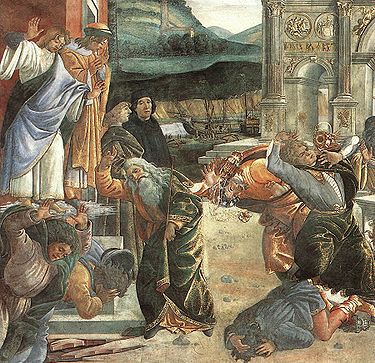
Summary
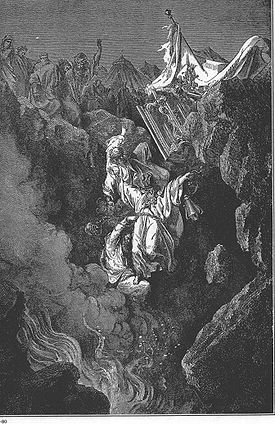

Korah’s rebellion
The LeviteLevite
In Jewish tradition, a Levite is a member of the Hebrew tribe of Levi. When Joshua led the Israelites into the land of Canaan, the Levites were the only Israelite tribe that received cities but were not allowed to be landowners "because the Lord the God of Israel himself is their inheritance"...
Korah son of Izhar joined with the Reubenites
Tribe of Reuben
According to the Hebrew Bible, the Tribe of Reuben was one of the Tribes of Israel.From after the conquest of the land by Joshua until the formation of the first Kingdom of Israel in c. 1050 BC, the Tribe of Reuben was a part of a loose confederation of Israelite tribes. No central government...
Dathan
Dathan
Dathan was an Israelite mentioned in the Old Testament as a participant of the Exodus.He was a son of Eliab, the son of Pallu, the son of Reuben. Together with his brother Abiram, the Levite Korah and others, he rebelled against Moses and Aaron...
and Abiram
Abiram
Abiram, also spelled Abiron, |father]] is exalted") is the name of two people in the Old Testament. One was the son of Eliab, who, along with his brother Dathan, joined Korah in the conspiracy against Moses and Aaron. He and all the conspirators, with their families and possessions, were swallowed...
sons of Eliab and On son of Peleth and 250 chieftains
Tribal chief
A tribal chief is the leader of a tribal society or chiefdom. Tribal societies with social stratification under a single leader emerged in the Neolithic period out of earlier tribal structures with little stratification, and they remained prevalent throughout the Iron Age.In the case of ...
of the Israelite
Israelite
According to the Bible the Israelites were a Hebrew-speaking people of the Ancient Near East who inhabited the Land of Canaan during the monarchic period .The word "Israelite" derives from the Biblical Hebrew ישראל...
community to rise up against Moses
Moses
Moses was, according to the Hebrew Bible and Qur'an, a religious leader, lawgiver and prophet, to whom the authorship of the Torah is traditionally attributed...
. Moses told Korah and his band to take their fire pans
Censer
Censers are any type of vessels made for burning incense. These vessels vary greatly in size, form, and material of construction. They may consist of simple earthenware bowls or fire pots to intricately carved silver or gold vessels, small table top objects a few centimetres tall to as many as...
and put fire and incense
Incense
Incense is composed of aromatic biotic materials, which release fragrant smoke when burned. The term "incense" refers to the substance itself, rather than to the odor that it produces. It is used in religious ceremonies, ritual purification, aromatherapy, meditation, for creating a mood, and for...
on them before God
Names of God in Judaism
In Judaism, the name of God is more than a distinguishing title; it represents the Jewish conception of the divine nature, and of the relationship of God to the Jewish people and to the world. To demonstrate the sacredness of the names of God, and as a means of showing respect and reverence for...
. Moses sent for Dathan and Abiram, but they refused to come. The next day, Korah and his band took their fire pans and gathered the whole community against Moses and Aaron
Aaron
In the Hebrew Bible and the Qur'an, Aaron : Ααρών ), who is often called "'Aaron the Priest"' and once Aaron the Levite , was the older brother of Moses, and a prophet of God. He represented the priestly functions of his tribe, becoming the first High Priest of the Israelites...
at the entrance of the Tabernacle
Tabernacle
The Tabernacle , according to the Hebrew Torah/Old Testament, was the portable dwelling place for the divine presence from the time of the Exodus from Egypt through the conquering of the land of Canaan. Built to specifications revealed by God to Moses at Mount Sinai, it accompanied the Israelites...
. The Presence of the Lord appeared to the whole community, and God told Moses and Aaron to stand back so that God could annihilate the others. Moses and Aaron fell on their faces and implored God not to punish the whole community. God told Moses to instruct the community to move away from the tent
Tent
A tent is a shelter consisting of sheets of fabric or other material draped over or attached to a frame of poles or attached to a supporting rope. While smaller tents may be free-standing or attached to the ground, large tents are usually anchored using guy ropes tied to stakes or tent pegs...
s of Korah, Dathan, and Abiram, and they did so, while Dathan, Abiram, and their families stood at the entrance of their tents. Moses told the Israelites that if these men were to die of natural causes, then God did not send Moses, but if God caused the earth to swallow them up, then these men had spurned God. Just as Moses finished speaking, the earth opened and swallowed them, their households, and all Korah’s people, and the Israelites fled in terror.
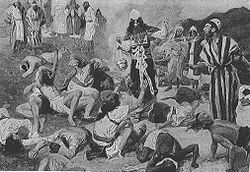
Eleazar
Eleazar , was a priest in the Hebrew Bible, the second Kohen Gadol - succeeding his father Aaron. He was a nephew of Moses.-Life:...
the priest
Kohen
A Kohen is the Hebrew word for priest. Jewish Kohens are traditionally believed and halachically required to be of direct patrilineal descent from the Biblical Aaron....
to remove the fire pans — as they had become sacred — and have them made into plating for the altar
Altar
An altar is any structure upon which offerings such as sacrifices are made for religious purposes. Altars are usually found at shrines, and they can be located in temples, churches and other places of worship...
to remind the Israelites that no one other than Aaron’s offspring should presume to offer incense to God.
A plague upon rebels
The next day, the whole Israelite community railed against Moses and Aaron for bringing death upon God’s people. A cloud covered the Tabernacle and the God’s Presence appeared. God told Moses to remove himself and Aaron from the community, so that God might annihilate them, and they fell on their faces. Moses told Aaron to take the fire pan, put fire from the altar and incense on it, and take it to the community to make expiation for them and to stop a plague that had begun, and Aaron did so. Aaron stood between the dead and the living and halted the plague, but not before 14,700 had died.
Aaron’s budding staff
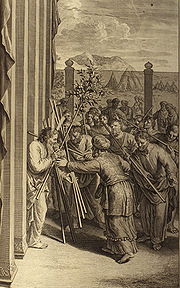
Almond
The almond , is a species of tree native to the Middle East and South Asia. Almond is also the name of the edible and widely cultivated seed of this tree...
s. God instructed Moses to put Aaron’s staff
Aaron's rod
Aaron's rod refers to any of the staves carried by Moses' brother, Aaron, in the Old Testament of the Bible. The Bible tells how, along with Moses' rod, Aaron's rod was endowed with miraculous power during the Plagues of Egypt which preceded the Exodus...
before the Ark of the Covenant
Ark of the Covenant
The Ark of the Covenant , also known as the Ark of the Testimony, is a chest described in Book of Exodus as solely containing the Tablets of Stone on which the Ten Commandments were inscribed...
to be kept as a lesson to rebels to end their mutterings against God. But the Israelites cried to Moses, “We are doomed to perish!”
Duties of priests and Levites
God assigned the Levites to Aaron to aid in the duties of the Tent of Meeting. God prohibited any outsider from intruding on the priests as they discharged the duties connected with the Shrine, on pain of death. And God gave Aaron and the priests all the sacred donationsKorban
The term offering as found in the Hebrew Bible in relation to the worship of Ancient Israel is mainly represented by the Hebrew noun korban whether for an animal or other offering...
and first fruits as a perquisite for all time for them and their families to eat. And God gave them the oil
Olive oil
Olive oil is an oil obtained from the olive , a traditional tree crop of the Mediterranean Basin. It is commonly used in cooking, cosmetics, pharmaceuticals, and soaps and as a fuel for traditional oil lamps...
, wine
Wine
Wine is an alcoholic beverage, made of fermented fruit juice, usually from grapes. The natural chemical balance of grapes lets them ferment without the addition of sugars, acids, enzymes, or other nutrients. Grape wine is produced by fermenting crushed grapes using various types of yeast. Yeast...
, grain
Cereal
Cereals are grasses cultivated for the edible components of their grain , composed of the endosperm, germ, and bran...
, and money
Money
Money is any object or record that is generally accepted as payment for goods and services and repayment of debts in a given country or socio-economic context. The main functions of money are distinguished as: a medium of exchange; a unit of account; a store of value; and, occasionally in the past,...
that the Israelites brought. But God told Aaron that the priests would have no territorial share among the Israelites, as God was their portion and their share. God gave the Levites all the tithes in Israel as their share in return for the services of the Tent of Meeting, but they too would have no territorial share among the Israelites. God told Moses to instruct the Levites to set aside one-tenth of the tithes they received as a gift to God.
Numbers chapter 16
A midrash taught that Korah took issue with Moses in because Moses had (as reports) appointed Elizaphan the son of UzzielUzziel
According to the Torah, Uzziel |El]] is my strength or God is my strength) was the father of Mishael, Elzaphan, and Zithri, and was a son of Kohath and grandson of Levi, consequently being the brother of Amram and uncle of Aaron, Miriam, and Moses...
as prince of the Kohathites
Kohathites
The Kohathites were one of the four main divisions among the Levites in Biblical times. The Bible claims that the Kohathites were all descended from the eponymous Kohath, a son of Levi, although some biblical scholars regard this as a postdictional metaphor providing an aetiology of the...
, and Korah was (as reports) son of Uzziel's older brother Izhar, and thus had a claim to leadership prior to Elizaphan. (Midrash Tanhuma
Tanhuma
Midrash Tanhuma is the name given to three different collections of Pentateuch haggadot; two are extant, while the third is known only through citations. These midrashim, although bearing the name of R. Tanḥuma, must not be regarded as having been written or edited by him...
Korah 1.)
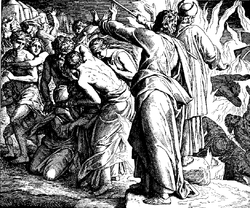
Gemara
The Gemara is the component of the Talmud comprising rabbinical analysis of and commentary on the Mishnah. After the Mishnah was published by Rabbi Judah the Prince The Gemara (also transliterated Gemora or, less commonly, Gemorra; from Aramaic גמרא gamar; literally, "[to] study" or "learning by...
deduced that he was called Korah because he caused a bald spot to be formed among the Israelites when the earth swallowed his followers. As the name Izhar in derived from the same Hebrew root as the word “noon” (tzohorayim), the Gemara deduced from “son of Izhar” that Korah was a son who brought upon himself anger hot as the noon sun. As the name Kohath in derived from the same Hebrew root as the word for “set on edge” (hikah), the Gemara deduced from “son of Kohath” that Korah was a son who set his ancestors’ teeth on edge. The Gemara deduced from the words “son of Levi” in that Korah was a son who was escorted to Gehenna
Gehenna
Gehenna , Gehinnom and Yiddish Gehinnam, are terms derived from a place outside ancient Jerusalem known in the Hebrew Bible as the Valley of the Son of Hinnom ; one of the two principal valleys surrounding the Old City.In the Hebrew Bible, the site was initially where apostate Israelites and...
. The Gemara asked why did not say “the son of Jacob,” and Rabbi Samuel bar Isaac answered that Jacob had prayed not to be listed amongst Korah's ancestors in Genesis where it is written, “Let my soul not come into their council; unto their assembly let my glory not be united.” “Let my soul not come into their council” referred to the spies, and “unto their assembly let my glory not be united” referred to Korah’s assembly. As the name Dathan in derived from the same Hebrew root as the word “law” (dath), the Gemara deduced from Dathan’s name that he violated God’s law. The Gemara related the name Abiram in to the Hebrew word for “strengthened” (iber) and deduced from Abiram’s name that he stoutly refused to repent. The Gemara related the name On in to the Hebrew word for “mourning” (aninut) and deduced from On’s name that he sat in lamentations. The Gemara related the name Peleth in to the Hebrew word for “miracles” (pelaot) and deduced from Peleth’s name that God performed wonders for him. And as the name Reuben derived from the Hebrew words “see” (reu) and “understand” (mavin), the Gemara deduced from the reference to On as a “son of Reuben” in that On was a son who saw and understood. (Babylonian Talmud
Talmud
The Talmud is a central text of mainstream Judaism. It takes the form of a record of rabbinic discussions pertaining to Jewish law, ethics, philosophy, customs and history....
Sanhedrin 109b.)
reports that the Reubenite On son of Peleth joined Korah’s conspiracy, but the text does not mention On again. Rab
Abba Arika
Abba Arika was a Jewish Talmudist who lived in Babylonia, known as an amora of the 3rd century who established at Sura the systematic study of the rabbinic traditions, which, using the Mishnah as text, led to the compilation of the Talmud...
explained that On’s wife saved him, arguing to him that no matter whether Moses or Korah prevailed, On would remain just a disciple. On replied that he had sworn to participate. So On’s wife got him drunk with wine, and laid him down in their tent. Then she sat at the entrance of their tent and loosened her hair, so that whoever came to summon him saw her and retreated at the sight of her immodestly loosened hair. The Gemara taught that Proverbs
Book of Proverbs
The Book of Proverbs , commonly referred to simply as Proverbs, is a book of the Hebrew Bible.The original Hebrew title of the book of Proverbs is "Míshlê Shlomoh" . When translated into Greek and Latin, the title took on different forms. In the Greek Septuagint the title became "paroimai paroimiae"...
refers to On’s wife when it says: “Every wise woman builds her house.” (Babylonian Talmud Sanhedrin 109b–10a.)
The Mishnah
Mishnah
The Mishnah or Mishna is the first major written redaction of the Jewish oral traditions called the "Oral Torah". It is also the first major work of Rabbinic Judaism. It was redacted c...
in Pirkei Avot deduced that the controversy of Korah and his followers was not for the sake of Heaven, and thus was destined not to result in permanent change. The Mishnah contrasted Korah’s argument to those between Hillel
Hillel the Elder
Hillel was a famous Jewish religious leader, one of the most important figures in Jewish history. He is associated with the development of the Mishnah and the Talmud...
and Shammai
Shammai
Shammai was a Jewish scholar of the 1st century, and an important figure in Judaism's core work of rabbinic literature, the Mishnah....
, which the Mishnah taught were controversies for the sake of Heaven, destined to result in something permanent. (Mishnah Avot 5:17.)
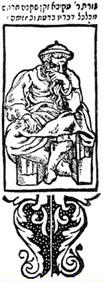
Rav Adda bar Abahah taught that a person praying alone does not say the Sanctification (Kedusha
Kedusha
The Kedushah is traditionally the third section of all Amidah recitations. In the silent Amidah it is a short prayer, but in the repetition, which requires a minyan, it is considerably lengthier...
h) prayer (which includes the words from קָדוֹשׁ קָדוֹשׁ קָדוֹשׁ יְהוָה צְבָאוֹת; מְלֹא כָל-הָאָרֶץ, כְּבוֹדוֹ, Kadosh, Kadosh, Kadosh, Adonai Tz'vaot melo kol haaretz kevodo, “Holy, Holy, Holy, the Lord of Hosts, the entire world is filled with God’s Glory”), because Leviticus says: “I will be hallowed among the children of Israel,” and thus sanctification requires ten people (a minyan
Minyan
A minyan in Judaism refers to the quorum of ten Jewish adults required for certain religious obligations. According to many non-Orthodox streams of Judaism adult females count in the minyan....
). Rabinai the brother of Rabbi Hiyya bar Abba taught that we derive this by drawing an analogy between the two occurrences of the word “among” (תּוֹךְ, toch) in (“I will be hallowed among the children of Israel”) and in in which God tells Moses and Aaron: “Separate yourselves from among this congregation,” referring to Korah and his followers. Just as which refers to a congregation, implies a number of at least ten, so implies at least ten. (Babylonian Talmud Berakhot 21b.)
The Mishnah in Pirkei Avot taught that the opening of the earth’s mouth in was one of ten miracles that God created at the end of the first week of creation at the eve of the Sabbath at twilight. (Mishnah Avot 5:6.)
Rabbi Akiba interpreted to teach that Korah’s assembly will have no portion in the world to come, as the words “the earth closed upon them” reported that they died in this world, and the words “they perished from among the assembly” implied that they died in the next world, as well. But Rabbi Eliezer disagreed, reading 1 Samuel
Books of Samuel
The Books of Samuel in the Jewish bible are part of the Former Prophets, , a theological history of the Israelites affirming and explaining the Torah under the guidance of the prophets.Samuel begins by telling how the prophet Samuel is chosen by...
to speak of Korah’s assembly when it said: “The Lord kills, and makes alive; He brings down to the grave, and brings up.” The Gemara cited a Tanna
Tannaim
The Tannaim were the Rabbinic sages whose views are recorded in the Mishnah, from approximately 70-200 CE. The period of the Tannaim, also referred to as the Mishnaic period, lasted about 130 years...
who concurred with Rabbi Eliezer’s position: Rabbi Judah ben Bathyra
Judah ben Bathyra
Judah ben Bathyra or simply Judah Bathyra was an eminent tanna. He must have lived before the destruction of the Temple, since he prevented a pagan in Jerusalem from partaking of the Paschal offering...
likened Korah’s assembly to a lost article, which one seeks, as Psalm
Psalms
The Book of Psalms , commonly referred to simply as Psalms, is a book of the Hebrew Bible and the Christian Bible...
said: “I have gone astray like a lost sheep; seek Your servant.” (Mishnah Sanhedrin 10:3; Babylonian Talmud Sanhedrin 108a, 109b.)
A Tanna in the name of Rabbi
Judah haNasi
Judah the Prince, or Judah I, also known as Rebbi or Rabbeinu HaKadosh , was a 2nd-century CE rabbi and chief redactor and editor of the Mishnah. He was a key leader of the Jewish community during the Roman occupation of Judea . He was of the Davidic line, the royal line of King David, hence the...
deduced from the words “the sons of Korah did not die” in that Providence set up a special place for them to stand on high in Gehinnom
Gehenna
Gehenna , Gehinnom and Yiddish Gehinnam, are terms derived from a place outside ancient Jerusalem known in the Hebrew Bible as the Valley of the Son of Hinnom ; one of the two principal valleys surrounding the Old City.In the Hebrew Bible, the site was initially where apostate Israelites and...
. (Babylonian Talmud Megillah 14a, Sanhedrin 110a.) There, Korah’s sons sat and sang praises to God. Rabbah bar bar Hana
Rabbah bar bar Hana
Rabbah bar bar Hana was a Jewish Talmudist who lived in Babylonia, known as an Amora of the second generation. He was the grandson of Hana and the brother of Hiyya. He went to Palestine and became a pupil of Rav Yochanan, whose sayings he transmitted...
told that once when he was travelling, an Arab showed him where the earth swallowed Korah’s congregation. Rabbah bar bar Hana saw two cracks in the ground from which smoke issued. He took a piece of wool, soaked it in water, attached it to the point of his spear, and passed it over the cracks, and the wool was singed. The Arab told Rabbah bar bar Hana to listen, and he heard them saying, “Moses and his Torah are true, but Korah's company are liars.” The Arab told Rabbah bar bar Hana that every 30 days Gehinnom caused them to return for judgment, as if they were being stirred like meat in a pot, and every 30 days they said those same words. (Babylonian Talmud Sanhedrin 110a–b.)
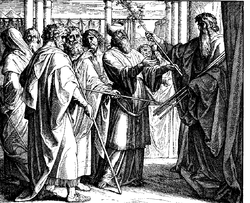
Numbers chapter 17
Rabbi Joshua ben LeviJoshua ben Levi
Joshua ben Levi or Yehoshua ben Levi was an amora who lived in the land of Israel of the first half of the third century. He headed the school of Lydda in the southern Land of Israel. He was an elder contemporary of Johanan bar Nappaha and Resh Lakish, who presided over the school in Tiberias...
explained how, as reports, Moses knew what to tell Aaron what to do to make atonement for the people, to stand between the dead and the living, and to check the plague. Rabbi Joshua ben Levi taught that when Moses ascended on high (as reports), the ministering angels asked God what business one born of woman had among them. God told them that Moses had come to receive the Torah. The angels questioned why God was giving to flesh and blood the secret treasure that God had hidden for 974 generations before God created the world. The angels asked, in the words of “What is man, that You are mindful of him, and the son of man, that You think of him?” God told Moses to answer the angels. Moses asked God what was written in the Torah. In God said, “I am the Lord your God, Who brought you out of the Land of Egypt.” So Moses asked the angels whether the angels had gone down to Egypt or were enslaved to Pharaoh. As the angels had not, Moses asked them why then God should give them the Torah. Again, says, “You shall have no other gods,” so Moses asked the angels whether they lived among peoples that engage in idol worship. Again, (20:8 in the NJPS) says, “Remember the Sabbath day, to keep it holy,” so Moses asked the angels whether they performed work from which they needed to rest. Again, (20:7 in the NJPS) says, “You shall not take the name of the Lord your God in vain,” so Moses asked the angels whether there were any business dealings among them in which they might swear oaths. Again, (20:12 in the NJPS) says, “Honor your father and your mother,” so Moses asked the angels whether they had fathers and mothers. Again, (20:13 in the NJPS) says, “You shall not murder; you shall not commit adultery; you shall not steal,” so Moses asked the angels whether there was jealousy among them and whether the Evil Tempter was among them. Immediately, the angels conceded that God’s plan was correct, and each angel felt moved to love Moses and give him gifts. Even the Angel of Death confided his secret to Moses, and that is how Moses knew what to do when, as reports, Moses told Aaron what to do to make atonement for the people, to stand between the dead and the living, and to check the plague. (Babylonian Talmud Shabbat 88b–89a.)
A Baraita
Baraita
Baraita designates a tradition in the Jewish oral law not incorporated in the Mishnah. "Baraita" thus refers to teachings "outside" of the six orders of the Mishnah...
taught that Josiah
Josiah
Josiah or Yoshiyahu or Joshua was a king of Judah who instituted major reforms. Josiah is credited by most historians with having established or compiled important Jewish scriptures during the Deuteronomic reform that occurred during his rule.Josiah became king of Judah at the age of eight, after...
hid the Ark, the bottle containing the manna
Manna
Manna or Manna wa Salwa , sometimes or archaically spelled mana, is the name of an edible substance that God provided for the Israelites during their travels in the desert according to the Bible.It was said to be sweet to the taste, like honey....
(see Exodus ), Aaron’s staff with its almonds and blossoms (see ), and the chest that the Philistines
Philistines
Philistines , Pleshet or Peleset, were a people who occupied the southern coast of Canaan at the beginning of the Iron Age . According to the Bible, they ruled the five city-states of Gaza, Askelon, Ashdod, Ekron and Gath, from the Wadi Gaza in the south to the Yarqon River in the north, but with...
sent as a gift (see ), because Josiah read in “The Lord will bring you, and your king whom you shall set over you, to a nation that you have not known.” Therefore he hid these things, as 2 Chronicles
Books of Chronicles
The Books of Chronicles are part of the Hebrew Bible. In the Masoretic Text, it appears as the first or last book of the Ketuvim . Chronicles largely parallels the Davidic narratives in the Books of Samuel and the Books of Kings...
reports: “And he said to the Levites, that taught all Israel, that were holy to the Lord: ‘Put the holy ark into the house that Solomon
Solomon
Solomon , according to the Book of Kings and the Book of Chronicles, a King of Israel and according to the Talmud one of the 48 prophets, is identified as the son of David, also called Jedidiah in 2 Samuel 12:25, and is described as the third king of the United Monarchy, and the final king before...
, the son of David
David
David was the second king of the united Kingdom of Israel according to the Hebrew Bible and, according to the Gospels of Matthew and Luke, an ancestor of Jesus Christ through both Saint Joseph and Mary...
, King of Israel built. There shall no more be a burden upon your shoulders now.’” (Babylonian Talmud Yoma 52b.)
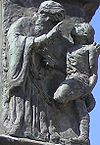
Numbers chapter 18
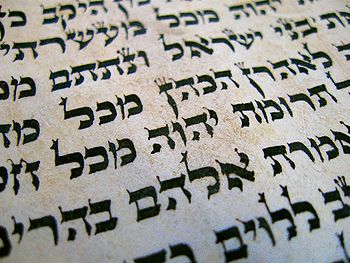
Shammai
Shammai was a Jewish scholar of the 1st century, and an important figure in Judaism's core work of rabbinic literature, the Mishnah....
to convert
Conversion to Judaism
Conversion to Judaism is a formal act undertaken by a non-Jewish person who wishes to be recognised as a full member of the Jewish community. A Jewish conversion is both a religious act and an expression of association with the Jewish people...
him to Judaism on condition that Shammai appoint him High Priest
Kohen Gadol
The High Priest was the chief religious official of Israelite religion and of classical Judaism from the rise of the Israelite nation until the destruction of the Second Temple of Jerusalem...
. Shammai pushed him away with a builder’s ruler. The non-Jew then went to Hillel, who converted him. The convert then read Torah, and when he came to the injunction of and that “the common man who draws near shall be put to death,” he asked Hillel to whom the injunction applied. Hillel answered that it applied even to David, King of Israel, who had not been a priest. Thereupon the convert reasoned a fortiori that if the injunction applied to all (non-priestly) Israelites, whom in God had called “my firstborn,” how much more so would the injunction apply to a mere convert, who came among the Israelites with just his staff and bag. Then the convert returned to Shammai, quoted the injunction, and remarked on how absurd it had been for him to ask Shammai to appoint him High Priest. (Babylonian Talmud Shabbat 31a.)
Tractate Terumot
Terumot
Terumot is the sixth tractate of Seder Zeraim of the Mishnah and of the Talmud. It discusses two type of donations, one the terumah which is generally 1/50 of your crop given to the Kohen and 10% of the Masser that is given to Levite is given to the Kohen, called "Terumat Masser." The laws of...
in the Mishnah, Tosefta
Tosefta
The Tosefta is a compilation of the Jewish oral law from the period of the Mishnah.-Overview:...
, and Jerusalem Talmud
Jerusalem Talmud
The Jerusalem Talmud, talmud meaning "instruction", "learning", , is a collection of Rabbinic notes on the 2nd-century Mishnah which was compiled in the Land of Israel during the 4th-5th century. The voluminous text is also known as the Palestinian Talmud or Talmud de-Eretz Yisrael...
interpreted the laws of the portion of the crop that was to be given to the priests in (Mishnah Terumot 1:1–11:10; Tosefta Terumot 1:1–10:18; Jerusalem Talmud Terumot 1a–107a.)
Tractate Bikkurim
Bikkurim (Talmud)
Bikkurim is the eleventh tractate of Seder Zeraim of the Mishnah and of the Talmud. All versions of the Mishnah contain the first three chapters, and some versions contain a fourth....
in the Mishnah, Tosefta, and Jerusalem Talmud interpreted the laws of the first fruits in and and (Mishnah Bikkurim 1:1–3:12; Tosefta Bikkurim 1:1–2:16; Jerusalem Talmud Bikkurim 1a–26b.)
Tractate Demai
Demai
Demai is the third tractate of Seder Zeraim of the Mishnah and of the Talmud. There is some debate as to the literal meaning and origin of the word...
in the Mishnah, Tosefta, and Jerusalem Talmud, interpreted the laws related to produce where one is not sure if it has been properly tithe
Tithe
A tithe is a one-tenth part of something, paid as a contribution to a religious organization or compulsory tax to government. Today, tithes are normally voluntary and paid in cash, cheques, or stocks, whereas historically tithes were required and paid in kind, such as agricultural products...
d in accordance with (Mishnah Demai 1:1–7:8; Tosefta Demai 1:1–8:24; Jerusalem Talmud Demai 1a–.)
Commandments
According to Sefer ha-ChinuchSefer ha-Chinuch
The Sefer ha-Chinuch , often simply "the Chinuch" is a work which systematically discusses the 613 commandments of the Torah. It was published anonymously in 13th century Spain...
, there are 5 positive and 4 negative commandments
Mitzvah
The primary meaning of the Hebrew word refers to precepts and commandments as commanded by God...
in the parshah.
- To guard the TempleTemple in JerusalemThe Temple in Jerusalem or Holy Temple , refers to one of a series of structures which were historically located on the Temple Mount in the Old City of Jerusalem, the current site of the Dome of the Rock. Historically, these successive temples stood at this location and functioned as the centre of...
area - No Levite must do another's work of either a Kohen or a Levite
- One who is not a Kohen must not serve in the sanctuary
- Not to leave the Temple unguarded
- To redeem the firstborn sonsPidyon HaBenThe Pidyon HaBen, or Redemption of the first born son, is a mitzvah in Judaism whereby a Jewish firstborn son is redeemed by use of silver coins from his birth-state of sanctity....
and give the money to a Kohen - Not to redeem the firstborn of a kosher domestic animal
- The Levites must work in the Temple
- To set aside a tithe each planting year and give it to a Levite
- The Levite must set aside a tenth of his tithe
Haftarah
The haftarahHaftarah
The haftarah or haftoroh is a series of selections from the books of Nevi'im of the Hebrew Bible that is publicly read in synagogue as part of Jewish religious practice...
for the parshah is
When the parshah coincides with Shabbat Rosh Chodesh (as it does in 2013 and 2017), the haftarah is Isaiah
Book of Isaiah
The Book of Isaiah is the first of the Latter Prophets in the Hebrew Bible, preceding the books of Ezekiel, Jeremiah and the Book of the Twelve...
In the liturgy
Some Jews read about how the earth swallowed Korah up in and how the controversy of Korah and his followers in was not for the sake of Heaven as they study Pirkei Avot chapter 5 on a Sabbath between PassoverPassover
Passover is a Jewish holiday and festival. It commemorates the story of the Exodus, in which the ancient Israelites were freed from slavery in Egypt...
and Rosh Hashanah
Rosh Hashanah
Rosh Hashanah , , is the Jewish New Year. It is the first of the High Holy Days or Yamim Nora'im which occur in the autumn...
. (Menachem Davis. The Schottenstein Edition Siddur for the Sabbath and Festivals with an Interlinear Translation, 571, 577. Brooklyn: Mesorah Publications
ArtScroll
ArtScroll is an imprint of translations, books and commentaries from an Orthodox Jewish perspective published by Mesorah Publications, Ltd., a publishing company based in Brooklyn, New York...
, 2002. ISBN 1-57819-697-3.)
And similarly, some Jews refer to the 24 priestly gifts deduced from and as they study chapter 6 of Pirkei Avot on another Sabbath between Passover and Rosh Hashanah. (Davis, Siddur for the Sabbath and Festivals, at 587.)
Biblical
(firstborn); (firstborn); (firstborn). (firstborn); (Korach, Dathan, Abiram). (firstborn). (not having taken a donkey).- JeremiahBook of JeremiahThe Book of Jeremiah is the second of the Latter Prophets in the Hebrew Bible, following the book of Isaiah and preceding Ezekiel and the Book of the Twelve....
(firstborn). - EzekielBook of EzekielThe Book of Ezekiel is the third of the Latter Prophets in the Hebrew Bible, following the books of Isaiah and Jeremiah and preceding the Book of the Twelve....
(rod blossomed); (elders burning incense). (God as inheritance); (go down alive into the nether-world); (Moses as God’s chosen); 29–30 (rebellion and earth swallowing; plague as God’s punishment).

Early nonrabbinic
- Pseudo-PhiloPseudo-PhiloPseudo-Philo is the name commonly used for a Jewish pseudepigraphical work in Latin, so called because it was transmitted along with Latin translations of the works of Philo of Alexandria but is very obviously not written by Philo...
16:1–17:4. - JosephusJosephusTitus Flavius Josephus , also called Joseph ben Matityahu , was a 1st-century Romano-Jewish historian and hagiographer of priestly and royal ancestry who recorded Jewish history, with special emphasis on the 1st century AD and the First Jewish–Roman War, which resulted in the Destruction of...
, Antiquities of the JewsAntiquities of the JewsAntiquities of the Jews is a twenty volume historiographical work composed by the Jewish historian Flavius Josephus in the thirteenth year of the reign of Roman emperor Flavius Domitian which was around 93 or 94 AD. Antiquities of the Jews contains an account of history of the Jewish people,...
4:2:1–4, 3:1–4, 4:1–2, 4. Circa 93–94. Reprinted in, e.g., The Works of Josephus: Complete and Unabridged, New Updated Edition. Translated by William WhistonWilliam WhistonWilliam Whiston was an English theologian, historian, and mathematician. He is probably best known for his translation of the Antiquities of the Jews and other works by Josephus, his A New Theory of the Earth, and his Arianism...
, 102–07. Peabody, Mass.: Hendrickson Pub., 1987. ISBN 0-913573-86-8. - JudeEpistle of JudeThe Epistle of Jude, often shortened to Jude, is the penultimate book of the New Testament and is attributed to Jude, the brother of James the Just. - Composition :...
(Korah’s rebellion). - PausaniasPausanias (geographer)Pausanias was a Greek traveler and geographer of the 2nd century AD, who lived in the times of Hadrian, Antoninus Pius and Marcus Aurelius. He is famous for his Description of Greece , a lengthy work that describes ancient Greece from firsthand observations, and is a crucial link between classical...
. Description of Greece, 2:31:10. Greece, 2nd Century C.E. (After HeraclesHeraclesHeracles ,born Alcaeus or Alcides , was a divine hero in Greek mythology, the son of Zeus and Alcmene, foster son of Amphitryon and great-grandson of Perseus...
leaned his club against the image of HermesHermesHermes is the great messenger of the gods in Greek mythology and a guide to the Underworld. Hermes was born on Mount Kyllini in Arcadia. An Olympian god, he is also the patron of boundaries and of the travelers who cross them, of shepherds and cowherds, of the cunning of thieves, of orators and...
, the club took root and grew.). - Qur'anQur'anThe Quran , also transliterated Qur'an, Koran, Alcoran, Qur’ān, Coran, Kuran, and al-Qur’ān, is the central religious text of Islam, which Muslims consider the verbatim word of God . It is regarded widely as the finest piece of literature in the Arabic language...
: 28:76–82; 29:39; 40:24–25. (In the Qur'an, Korah is named Qarun or Qaaroon; see Biblical narratives and the Qur'anBiblical narratives and the Qur'anThe Qur'an, the central religious text of Islam, contains references to over fifty people and events also found in the Bible. While the stories told in each book are generally comparable in most respects, important differences sometimes emerge....
.)
Classical rabbinic
- MishnahMishnahThe Mishnah or Mishna is the first major written redaction of the Jewish oral traditions called the "Oral Torah". It is also the first major work of Rabbinic Judaism. It was redacted c...
: Demai 1:1–7:8; Terumot 1:1–11:10; Challah 1:3; 4:9; Bikkurim 1:1–3:12; Chagigah 1:4; Sanhedrin 9:6; 10:3; Avot 5:6, 17; Bekhorot 8:8. Land of Israel, circa 200 C.E. Reprinted in, e.g., The Mishnah: A New Translation. Translated by Jacob NeusnerJacob NeusnerJacob Neusner is an American academic scholar of Judaism who lives in Rhinebeck, New York.-Biography:Born in Hartford, Connecticut, Neusner was educated at Harvard University, the Jewish Theological Seminary of America , the University of Oxford, and Columbia University.Neusner is often celebrated...
, 93–120, 148, 157, 329, 604–05, 686, 688, 806. New Haven: Yale University Press, 1988. ISBN 0-300-05022-4. - ToseftaToseftaThe Tosefta is a compilation of the Jewish oral law from the period of the Mishnah.-Overview:...
: Demai 1:1–8:24; Terumot 1:1–10:18; Maaser Sheni 3:11; Challah 2:7, 9; Shabbat 15:7; Chagigah 3:19; Sotah 7:4; Sanhedrin 13:9; Bekhorot 1:5. Land of Israel, circa 300 C.E. Reprinted in, e.g., The Tosefta: Translated from the Hebrew, with a New Introduction. Translated by Jacob Neusner, 1:77–202, 313, 339, 414, 677, 861; 2:1190, 1469. Peabody, Mass.: Hendrickson Pub., 2002. ISBN 1-56563-642-2. - Jerusalem TalmudJerusalem TalmudThe Jerusalem Talmud, talmud meaning "instruction", "learning", , is a collection of Rabbinic notes on the 2nd-century Mishnah which was compiled in the Land of Israel during the 4th-5th century. The voluminous text is also known as the Palestinian Talmud or Talmud de-Eretz Yisrael...
: Demai 1a–77b; Terumot 1a–107a; Maaser Sheni 4a, 5a, 53b–54a; Challah 9b, 23b, 29a, 33a; Orlah 18a, 20a; Bikkurim 1a–26b; Yoma 11a. Land of Israel, circa 400 CE. Reprinted in, e.g., Talmud Yerushalmi. Edited by Chaim Malinowitz, Yisroel Simcha Schorr, and Mordechai Marcus, vols. 4, 7–8, 10–12, 21. Brooklyn: Mesorah Publications, 2006–2011.

- Babylonian TalmudTalmudThe Talmud is a central text of mainstream Judaism. It takes the form of a record of rabbinic discussions pertaining to Jewish law, ethics, philosophy, customs and history....
: Berakhot 21b, 45a, 47a–b; Shabbat 25a, 26a, 89a, 127b, 135b; Eruvin 19a, 31b; Pesachim 23a, 34a, 35b, 54a, 64b, 73a, 121b; Yoma 24a, 27a, 44a, 45b, 52b, 74b; Sukkah 9a; Beitzah 3b, 12b–13b; Rosh Hashanah 12b; Megillah 9b, 23b; Moed Katan 5a–b, 12a, 13a, 16a, 18b, 28a; Chagigah 7b, 10b, 11b; Yevamot 74a, 85b–86b, 89b, 99b; Ketubot 8b, 72a, 102a; Nedarim 7b, 12b, 18b, 38a, 39b, 64b; Nazir 4b; Sotah 2a, 13b, 15a; Gittin 11b, 23b, 25a, 30b, 52a; Kiddushin 11b, 17a, 29a, 46b, 52b–53a; Bava Kamma 11b, 13a, 67a, 69b, 78a, 79a, 80a, 110b, 114a, 115b; Bava Metzia 6b, 22a, 56a, 71b, 88b, 102b; Bava Batra 74a, 84b, 112a, 118b, 143a; Sanhedrin 17a, 37b, 52a–b, 74b, 82b–84a, 90b, 108a, 109b–10a; Makkot 4a, 12a, 13a, 14b, 17a–b, 19a–b, 23b; Shevuot 4b, 17b, 39a; Avodah Zarah 15a, 24b; Horayot 12a; Zevachim 16a, 28a, 32a, 37a, 44b–45a, 49b, 57a, 60b, 63a, 73a, 81a, 88b, 91a, 97b, 102b; Menachot 9a, 19b, 21b, 23a, 37a, 54b, 58a, 73a, 77b, 83a, 84b, 99a; Chullin 68a, 99a, 120b, 130a, 131a–32b, 133b, 134b, 135b–36a; Bekhorot 3b–4b, 5b, 6b–7a, 10b, 11b–12b, 17a, 26b, 27b, 31b–33a, 34a, 47b, 49a, 50a, 51a–b, 53b, 54b, 56b, 58b–59a, 60a; Arakhin 4a, 11b, 16a, 28b–29a; Temurah 3a, 4b–5b, 8a, 21a–b, 24a; Keritot 4a, 5b; Meilah 8b; Tamid 26b; Niddah 26a, 29a. Babylonia, 6th Century. Reprinted in, e.g., Talmud Bavli. Edited by Yisroel Simcha Schorr, Chaim Malinowitz, and Mordechai Marcus, 72 vols. Brooklyn: Mesorah Pubs., 2006.
Medieval

- Avot of Rabbi NatanAvot of Rabbi NatanAvot de-Rabbi Nathan , usually printed together with the minor tractates of the Talmud, is a Jewish aggadic work probably compiled in the geonic era . Although Avot de-Rabbi Nathan is the first and longest of the "minor tractates", it probably does not belong in that collection chronologically,...
, 36:3. Circa 700–900 C.E. Reprinted in, e.g., The Fathers According to Rabbi Nathan. Translated by Judah Goldin, 149. New Haven: Yale Univ. Press, 1955. ISBN 0-300-00497-4. The Fathers According to Rabbi Nathan: An Analytical Translation and Explanation. Translated by Jacob Neusner, 217. Atlanta: Scholars Press, 1986. ISBN 1-55540-073-6. - Tanna Devei EliyahuTanna Devei EliyahuTanna Devei Eliyahu is the composite name of a midrash, consisting of two parts, whose final redaction took place at the end of the 10th century CE. The first part is called "Seder Eliyahu Rabbah" ; the second, "Seder Eliyahu Zuṭa"...
. Seder Eliyyahu Rabbah 67, 77, 83, 106, 117. 10th Century. Reprinted in, e.g., Tanna Debe Eliyyahu: The Lore of the School of Elijah. Translated by William G. Braude and Israel J. Kapstein, 150, 172, 183, 233, 256. Philadelphia: Jewish Publication Society, 1981. ISBN 0-8276-0634-6. - RashiRashiShlomo Yitzhaki , or in Latin Salomon Isaacides, and today generally known by the acronym Rashi , was a medieval French rabbi famed as the author of a comprehensive commentary on the Talmud, as well as a comprehensive commentary on the Tanakh...
. Commentary. Numbers 16–18. TroyesTroyesTroyes is a commune and the capital of the Aube department in north-central France. It is located on the Seine river about southeast of Paris. Many half-timbered houses survive in the old town...
, France, late 11th Century. Reprinted in, e.g., Rashi. The Torah: With Rashi’s Commentary Translated, Annotated, and Elucidated. Translated and annotated by Yisrael Isser Zvi Herczeg, 4:189–224. Brooklyn: Mesorah Publications, 1997. ISBN 0-89906-029-3. - Numbers RabbahNumbers RabbahNumbers Rabbah is a religious text holy to classical Judaism. It is a midrash comprising a collection of ancient rabbinical homiletic interpretations of the book of Numbers ....
18:1–23. 12th Century. Reprinted in, e.g., Midrash Rabbah: Numbers. Translated by Judah J. Slotki. London: Soncino Press, 1939. ISBN 0-900689-38-2. - MaimonidesMaimonidesMoses ben-Maimon, called Maimonides and also known as Mūsā ibn Maymūn in Arabic, or Rambam , was a preeminent medieval Jewish philosopher and one of the greatest Torah scholars and physicians of the Middle Ages...
. Mishneh TorahMishneh TorahThe Mishneh Torah subtitled Sefer Yad ha-Hazaka is a code of Jewish religious law authored by Maimonides , one of history's foremost rabbis...
, Structure. CairoCairoCairo , is the capital of Egypt and the largest city in the Arab world and Africa, and the 16th largest metropolitan area in the world. Nicknamed "The City of a Thousand Minarets" for its preponderance of Islamic architecture, Cairo has long been a centre of the region's political and cultural life...
, Egypt, 1170–1180.
.jpg)
- ZoharZoharThe Zohar is the foundational work in the literature of Jewish mystical thought known as Kabbalah. It is a group of books including commentary on the mystical aspects of the Torah and scriptural interpretations as well as material on Mysticism, mythical cosmogony, and mystical psychology...
3:176a–178b. Spain, late 13th Century. Reprinted in, e.g., The Zohar. Translated by Harry Sperling and Maurice Simon. 5 vols. London: Soncino Press, 1934.
Modern
- Thomas HobbesThomas HobbesThomas Hobbes of Malmesbury , in some older texts Thomas Hobbs of Malmsbury, was an English philosopher, best known today for his work on political philosophy...
. LeviathanLeviathan (book)Leviathan or The Matter, Forme and Power of a Common Wealth Ecclesiasticall and Civil — commonly called simply Leviathan — is a book written by Thomas Hobbes and published in 1651. Its name derives from the biblical Leviathan...
, 3:38, 40, 42. England, 1651. Reprint edited by C. B. MacphersonC. B. MacphersonCrawford Brough Macpherson O.C. M.Sc. D. Sc. was an influential Canadian political scientist who taught political theory at the University of Toronto.-Life:...
, 485–86, 505, 563–64. Harmondsworth, England: Penguin Classics, 1982. ISBN 0140431950. - Samson Raphael HirschSamson Raphael HirschSamson Raphael Hirsch was a German rabbi best known as the intellectual founder of the Torah im Derech Eretz school of contemporary Orthodox Judaism...
. Horeb: A Philosophy of Jewish Laws and Observances. Translated by Isidore Grunfeld, 189–95, 261–65. London: Soncino Press, 1962. Reprinted 2002 ISBN 0-900689-40-4. Originally published as Horeb, Versuche über Jissroel’s Pflichten in der Zerstreuung. Germany, 1837. - Thomas MannThomas MannThomas Mann was a German novelist, short story writer, social critic, philanthropist, essayist, and 1929 Nobel Prize laureate, known for his series of highly symbolic and ironic epic novels and novellas, noted for their insight into the psychology of the artist and the intellectual...
. Joseph and His BrothersJoseph and His BrothersJoseph and His Brothers is a four-part novel by Thomas Mann, written over the course of 16 years. Mann retells the familiar stories of Genesis, from Jacob to Joseph , setting it in the historical context of the Amarna Period...
. Translated by John E. WoodsJohn E. WoodsJohn E. Woods is a translator who specializes in translating German literature, since about 1978. His work includes much of the fictional prose of Arno Schmidt and the works of contemporary authors such as Ingo Schulze and Christoph Ransmayr...
, 55. New York: Alfred A. Knopf, 2005. ISBN 1-4000-4001-9. Originally published as Joseph und seine Brüder. Stockholm: Bermann-Fischer Verlag, 1943. - A. M. KleinA. M. KleinAbraham Moses Klein was a Canadian poet, journalist, novelist, short story writer, and lawyer. He has been called "One of Canada's greatest poets and a leading figure in Jewish-Canadian culture."...
. “Candle Lights.” Canada, 1944. Reprinted in The Collected Poems of A.M. Klein, 13. Toronto: McGraw-Hill Ryerson, 1974. ISBN 0-07-077625-3. - Jacob MilgromJacob MilgromJacob Milgrom was a prominent American Jewish Bible scholar and Conservative rabbi, best known for his comprehensive Torah commentaries and work on the Dead Sea Scrolls.-Biography:...
. “First fruits, OT.” In The Interpreter’s Dictionary of the Bible. Supp. vol., 336–37. Nashville, Tenn.: Abingdon, 1976. ISBN 0-687-19269-2. - Jacob Milgrom. The JPS Torah Commentary: Numbers: The Traditional Hebrew Text with the New JPS Translation, 129–57, 414–36. Philadelphia: Jewish Publication Society, 1990. ISBN 0-8276-0329-0.
- Howard Handler. “Pidyon HaBen and Caesarean Sections.” New York: Rabbinical Assembly, 1991. YD 305:24.1991. Reprinted in Responsa: 1991–2000: The Committee on Jewish Law and Standards of the Conservative Movement. Edited by Kassel Abelson and David J. Fine, 171–74. New York: Rabbinical Assembly, 2002. ISBN 0-916219-19-4.
- Baruch A. Levine. Numbers 1–20, 4:403–53. New York: Anchor Bible, 1993. ISBN 0-385-15651-0.
- Gerald Skolnik. “Should There Be a Special Ceremony in Recognition of a First-Born Female Child?” New York: Rabbinical Assembly, 1993. YD 305:1.1993. Reprinted in Responsa: 1991–2000: The Committee on Jewish Law and Standards of the Conservative Movement. Edited by Kassel Abelson and David J. Fine, 163–65 New York: Rabbinical Assembly, 2002. ISBN 0-916219-19-4.
- Mary DouglasMary DouglasDame Mary Douglas, DBE, FBA was a British anthropologist, known for her writings on human culture and symbolism....
. In the Wilderness: The Doctrine of Defilement in the Book of Numbers, 40, 59, 84, 103, 110–12, 122–23, 125, 130–33, 138, 140, 145, 147, 150, 194–95, 203, 211, 246. Oxford: Oxford University Press, 1993. Reprinted 2004. ISBN 0-19-924541-X. - Elliot N. DorffElliot N. DorffElliot N. Dorff is a Conservative rabbi. He is a professor of Jewish theology at the American Jewish University in California , author and a bio-ethicist....
. “Artificial Insemination, Egg Donation and Adoption.” New York: Rabbinical Assembly, 1994. EH 1:3.1994. Reprinted in Responsa: 1991–2000: The Committee on Jewish Law and Standards of the Conservative Movement. Edited by Kassel Abelson and David J. Fine, 461, 497. New York: Rabbinical Assembly, 2002. ISBN 0-916219-19-4. (implications of the law of the firstborn son for deciding whether a child born from a donated egg is Jewish). - Vernon Kurtz. “Delay of Pidyon HaBen” New York: Rabbinical Assembly, 1995. YD 305:11.1995. Reprinted in Responsa: 1991–2000: The Committee on Jewish Law and Standards of the Conservative Movement. Edited by Kassel Abelson and David J. Fine, 166–70. New York: Rabbinical Assembly, 2002. ISBN 0-916219-19-4.
- Elie WieselElie WieselSir Eliezer "Elie" Wiesel KBE; born September 30, 1928) is a Hungarian-born Jewish-American writer, professor, political activist, Nobel Laureate, and Holocaust survivor. He is the author of 57 books, including Night, a work based on his experiences as a prisoner in the Auschwitz, Buna, and...
. “Korah.” Bible ReviewBible ReviewBible Review was a publication that sought to connect the academic study of the Bible to a broad general audience. Covering both the Old and New Testaments, Bible Review presented critical and historical interpretations of biblical texts, and “reader-friendly Biblical scholarship” from 1985 to...
16 (3) (June 2000): 12–15. - Suzanne A. Brody. “Direct Line to G-d.” In Dancing in the White Spaces: The Yearly Torah Cycle and More Poems, 97. Shelbyville, Kentucky: Wasteland Press, 2007. ISBN 1-60047-112-9.
Texts
Commentaries

- Academy for Jewish Religion, California
- Academy for Jewish Religion, New York
- Aish.com
- American Jewish University
- Anshe Emes Synagogue, Los Angeles
- Bar-Ilan University
- Chabad.org
- eparsha.com
- G-dcast
- The Israel Koschitzky Virtual Beit Midrash
- Jewish Agency for Israel
- Jewish Theological Seminary
- Miriam Aflalo
- MyJewishLearning.com
- Ohr Sameach
- Orthodox Union
- OzTorah, Torah from Australia
- Oz Ve Shalom — Netivot Shalom
- Pardes from Jerusalem
- RabbiShimon.com
- Rabbi Shlomo Riskin
- Rabbi Shmuel Herzfeld
- Reconstructionist Judaism
- Sephardic Institute
- Shiur.com
- 613.org Jewish Torah Audio
- Tanach Study Center
- Torah from Dixie
- Torah.org
- TorahVort.com
- Union for Reform Judaism
- United Hebrew Congregations of the Commonwealth
- United Synagogue of Conservative Judaism
- What’s Bothering Rashi?
- Yeshiva University
- Yeshivat Chovevei Torah

